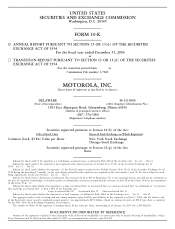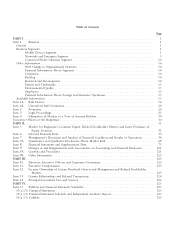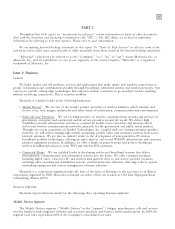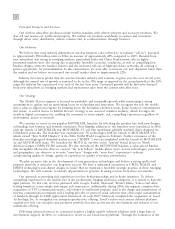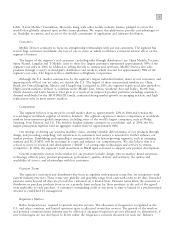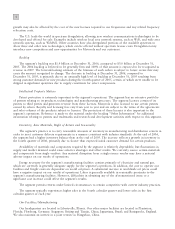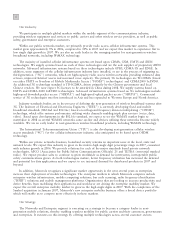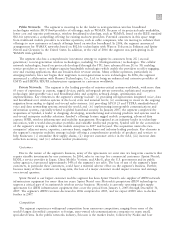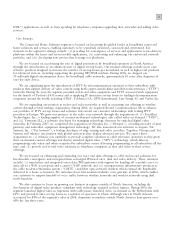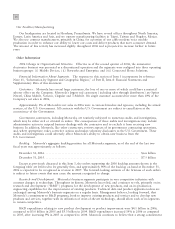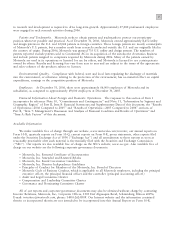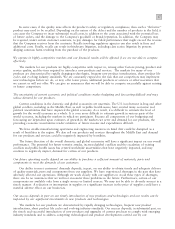Motorola 2006 Annual Report Download - page 16
Download and view the complete annual report
Please find page 16 of the 2006 Motorola annual report below. You can navigate through the pages in the report by either clicking on the pages listed below, or by using the keyword search tool below to find specific information within the annual report.
8
vendors with similar market share positions, including Motorola, Siemens, Alcatel-Lucent and Nortel. Samsung,
NEC and local Chinese vendors are also significant competitors. In the private networks industry, the segment
provides communications and information systems compliant with both existing industry digital standards, TETRA
and APCO 25. Major competitors include: M/A-Com, EADS Telecommunications, Kenwood, EF Johnson and
large system integrators. The segment may also act as a subcontractor to a large system integrator based on a
number of competitive factors and customer requirements. As demand for fully-integrated voice, data and
broadband over wireless systems at the local, state and national government levels continues, the segment may face
additional competition from public telecommunications carriers. In the enterprise market, the segment experiences
competition from Cisco, Nokia, and Intermec.
Competitive factors in the market for the segment's products include: technology offered; price; payment
terms; availability of vendor financing; product and system performance; product features, quality, delivery,
availability and warranty; the quality and availability of service; company image; relationship with key customers;
and time-to-market. Price is a major area of competition and often impacts margins for initial system bids,
particularly in emerging markets. Time-to-market has also been an important competitive factor, especially for new
systems and technologies.
The segment's public networks business is confronting several factors that could impact its business, including
the consolidation among telecommunications equipment providers and unclear timing for the granting of new
licenses for providers in countries like China. In addition, the segment does not believe future iDEN technology
revenues are likely to match 2006 levels. In the private networks space, the segment is managing the impact of
system integrators seeking to move farther into the public safety area. In the enterprise market, a number of
competitors deliver products in certain segments of the enterprise mobility market. The segment believes it has a
unique portfolio to seamlessly connect people, assets and information to enable customers to grow their business,
increase efficiency and improve customer satisfaction. Security and manageability are common throughout the
portfolio.
Payment Terms
Payment terms vary worldwide, depending on the arrangement. Contracts for communication systems typically
include implementation milestones, such as delivery, installation and system acceptance, which can take 30 to
180 days to complete. Invoicing the customer is dependent on the completion of the milestone. Customer payments
are generally due 30 to 60 days from the invoice date.
As required for competitive reasons, we may provide or work with third-party lenders to arrange for long-term
financing in connection with equipment purchases. Financing may cover all or a portion of the purchase price. The
segment's payment terms are consistent with industry practice as many of our contracts are awarded through a
competitive bid process.
Regulatory Matters
The use of wireless voice and data communications systems is regulated by a variety of governmental and other
regulatory agencies throughout the world. In the U.S., non-Federal users of these systems are licensed by the
Federal Communications Commission (""FCC''), which has broad authority to make rules and regulations and
prescribe restrictions and conditions to carry out the provisions of the Communications Act of 1934. Similarly,
Federal agency operation of wireless communications systems is regulated by the National Telecommunications and
Information Agency (""NTIA''). Regulatory agencies in other countries have similar types of authority.
Consequently, the business and results of this segment could be affected by the rules and regulations adopted by
the FCC, NTIA or regulatory agencies in other countries from time to time. Motorola has developed products
using trunking and data communications technologies to enhance spectral efficiencies. The growth and results of
the wireless communications industry may be affected by the regulations of the FCC, NTIA or other regulatory
agencies relating to the access to allocated spectrum for wireless communications users, especially in urban areas
where spectrum is heavily used.
The U.S. leads the world in spectrum deregulation, allowing new wireless communications technologies to be
developed and offered for sale. Examples include wireless local area network systems, such as WiFi, mesh
technologies and wide area network systems, such as Motorola's Wi4 portfolio, including WiMAX. Other countries
have also deregulated portions of the available spectrum to allow the deployment of these and other technologies.
Deregulation may introduce new competition and new opportunities for Motorola and our customers.



